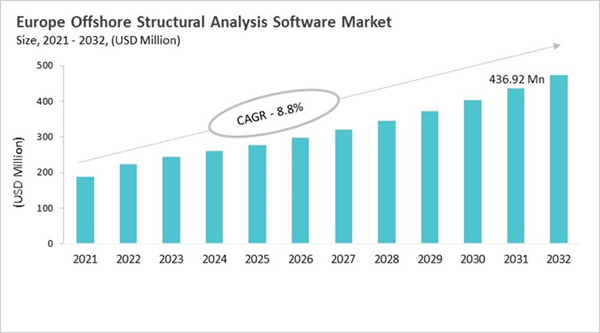The UK market dominated the Europe Offshore Structural Analysis Software Market by country in 2024, and is expected to continue to be a dominant market till 2032; thereby, achieving a market value of $102.5 Million by 2032. The Germany market is exhibiting a CAGR of 6.6% during 2025-2032. Additionally, the France market is expected to experience a CAGR of 9% during 2025-2032. The UK and Germany led the Europe Offshore Structural Analysis Software Market by Country with a market share of 23.9% and 14.3% in 2024. The Spain market is expected to witness a CAGR of 9.6% during throughout the forecast period.
The European offshore structural analysis software market has grown from a small, oil and gas-focused area to a large, multi-sector engineering ecosystem that supports offshore wind, marine renewables, and defense projects. This change happened because there was a need for a single model that combined structural mechanics, hydrodynamics, fatigue, corrosion modeling, and regulatory compliance. This change happened faster because of the rise of offshore wind, which needed tools that could handle floating foundations, aero-hydro-elastic simulations, and interactions between soil and structures. Faster, more accurate design iterations and probabilistic analyses are now possible thanks to improvements in solver fidelity, multiphysics integration, cloud computing, and parametric modeling. Regulatory requirements and cost pressures have made it even more important to use lifecycle-oriented features like digital twins and automated inspection planning to extend the life of assets and lower operational risks.
Market leaders are focusing on strategies that include integrating workflows, forming partnerships with other companies in the ecosystem, and being the best in technology. Vendors put together modules that cover everything from feasibility to in-service assessment. This cuts down on errors when transferring data and speeds up the certification process. Strategic partnerships with OEMs, fabricators, and classification societies put software into standard project workflows, which speeds up adoption and makes sure it works with real-world limitations. To win big renewable and brownfield projects, it's important to have technological differentiation, such as high-performance solvers, cloud-enabled collaboration, and digital twin integration. There are global CAE vendors, marine software specialists, and classification bodies in the competitive landscape. Success is based on validated workflows, lifecycle support, regulatory alignment, and a strong customer service infrastructure.
Structure Type Outlook
Based on Structure Type, the market is segmented into Fixed Platforms, Floating Production Systems, and Offshore Wind Foundations. Among various Spain Offshore Structural Analysis Software Market by Structure Type; The Fixed Platforms market achieved a market size of USD $7.6 Million in 2024 and is expected to grow at a CAGR of 8.9 % during the forecast period. The Offshore Wind Foundations market is predicted to experience a CAGR of 10.1% throughout the forecast period from (2025 - 2032).Component Outlook
Based on Component, the market is segmented into Finite-Element Solvers, Integrated Suites, Hydrodynamic Modules, and Coupled Aero-Hydro-Servo Solvers. The Finite-Element Solvers market segment dominated the France Offshore Structural Analysis Software Market by Component is expected to grow at a CAGR of 8.2 % during the forecast period thereby continuing its dominance until 2032. Also, the Hydrodynamic Modules market is anticipated to grow as a CAGR of 9.6 % during the forecast period during 2025-2032.Country Outlook
The UK is an important market for offshore structural analysis software because its North Sea oil and gas sector is well-established, offshore wind is growing quickly, and the country has a lot of engineering expertise. To make sure safety, compliance, and efficiency, modeling fatigue, hydrodynamics, mooring, and soil-structure interaction requires software tools. High-fidelity, validated software, such as digital twin and lifecycle assessment capabilities, is becoming more popular because of regulatory requirements, aging infrastructure, and renewable energy projects. More people are using real-time sensor data, cloud collaboration, and multiphysics simulations for predictive maintenance and sustainability. Big companies like Bentley, Siemens, and Dassault Systèmes are in charge, while smaller companies focus on floating wind and fatigue. The ability to solve problems accurately, follow the rules, and integrate digital twins gives a company an edge over its competitors. The UK is a good place for advanced offshore analysis solutions because of its strict rules and focus on renewable energy.List of Key Companies Profiled
- Bentley Systems, Inc.
- ANSYS, Inc.
- Siemens AG
- DNV AS
- Autodesk, Inc.
- Ramboll Group A/S
- John Wood Group PLC
- Dlubal Software GmbH
- Stewart Technology Associates
- BakerRisk
Market Report Segmentation
By Deployment Model
- On-premise Licensing
- Cloud / SaaS
By Structure Type
- Fixed Platforms
- Floating Production Systems
- Offshore Wind Foundations
By Component
- Finite-Element Solvers
- Integrated Suites
- Hydrodynamic Modules
- Coupled Aero-Hydro-Servo Solvers
By End-use Industry
- Oil and Gas
- Offshore Wind
- Marine and Naval
- Wave and Tidal Energy
By Country
- Germany
- UK
- France
- Russia
- Spain
- Italy
- Rest of Europe
Table of Contents
Companies Mentioned
- Bentley Systems, Inc.
- ANSYS, Inc.
- Siemens AG
- DNV AS
- Autodesk, Inc.
- Ramboll Group A/S
- John Wood Group PLC
- Dlubal Software GmbH
- Stewart Technology Associates
- BakerRisk










